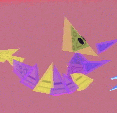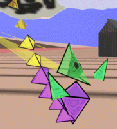
old thing

new thing
First some users had difficulty discerning the Thing's body. It is a collection of pyramids "tied" together my the motion captured movement. I expected people to move their arms in the same way that the Thing moved it's arms. Some users, however, simply wriggled about like hypnotized snakes - I realized that they were trying to copy the Thing's tail movements. Adding a verbal injunction to "move your arms and body like mine - don't worry about the tail," did not fully fix the problem. Dan Sandin suggested outlining the Thing's body and de-emphasizing the tail. This new look helped people to correctly identify the body and move their own bodies' accordingly.
To solve these problems I inserted some new behavior at the very beginning of the dance sequence. The Thing announces that it will show the user how to dance, then says that they must "loosen up a little first." It instructs the user to wave her arms above her head. The program performs checks to see :
- if the joystick or buttons are pressed - if so the user is instructed not to touch the buttons but to move only the body
- if the user is moving both arms - if not the user is instructed to move both arms
- if the user is trying hard enough, i.e.. are they waving there arms high enough - if so the Thing proceeds to teach the first dance step
Third I revised the Thing's speeches and the four cousins behavior thoughout the third act to clarify the back story- the taboo relationship which user and Thing have been caught in. Now as the four cousins approach, the Thing whispers asides that reveal that the dancing behavior that they were indulging in is heresy if it takes place between a meat-object, the user, and a Thing. As before the four cousins berate the Thing, but now they are more vicious and pull off its arm. This is to encourage the user to feel more protective of the Thing.
During the sequence where the user shoots at the cousins, all the Thing's phrases were revised. Many of them give more information about the back story. The Thing's mood and behavior also alter more radically depending on the user. If the user can't or won't shoot the cousins, the Thing begs her to protect it, and finally becomes furious and abusive. On the other hand if the user does shoot the cousins, and the faster she shoots, the Thing begins to have second thoughts and begs the user to spare her family members. All this is designed to increase the user's ambivalence towards the Thing.
Feedback from users and my committee indicated that these fixes, which comprised a second draft of the project, conveyed the story much more completely. The entire experience in this final version lasted between 10-15 minutes depending on the user. The final version first showed at my MFA show.